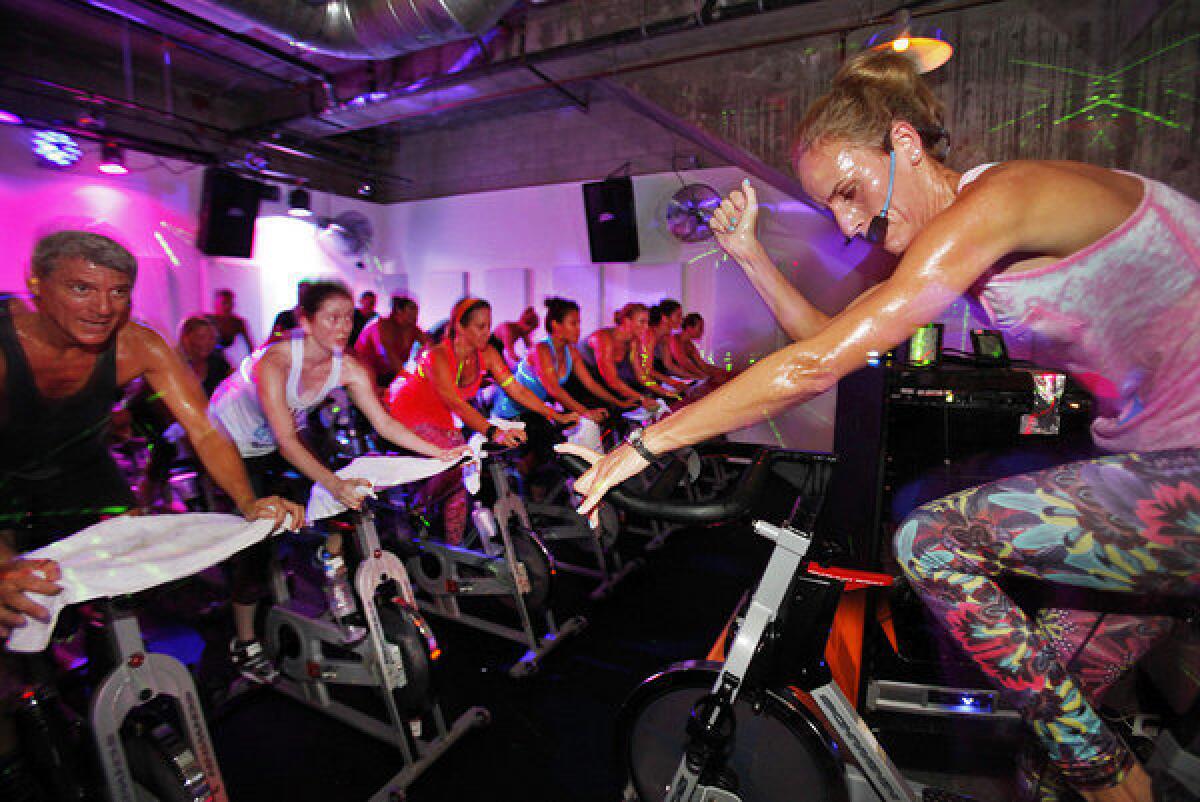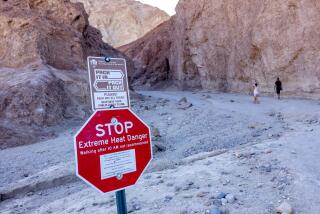Hot exercise classes catching on like fire

- Share via
Mimi Benz discovered her fervor for hot exercise by accident. She had taken heated yoga classes but had never thought to combine high temperatures with her true passion, indoor cycling, until the air conditioning broke during a cycling class at her gym.
From that first hot ride, she was hooked.
“I loved it,” says Benz, explaining that with a heated workout she didn’t have to waste time warming up. “It improves blood flow throughout your body, so you go into a high-calorie burn more quickly. And it feels really good afterwards.”
In 2011, Benz opened the Sweat Shoppe, a heated indoor cycling studio in North Hollywood.
“I wasn’t sure how people would respond, so in the beginning we had half heated classes and half non-heated classes.” But the demand for heated classes was so high that by 2013 they’d eliminated non-heated rides from the schedule.
As the demand for hot workouts continues to rise, heated studios are popping up all over, offering everything from traditional Bikram yoga, which started the hot exercise trend with a regimented sequence of yoga postures performed in a 105-degree room with 40% humidity, to hot power yoga, hot Pilates and hot barre. Some classes even incorporate hot weightlifting.
Bikram’s static poses can be sustained at over 100 degrees, but more dynamic classes are typically in the 95-degree range, and the Sweat Shoppe’s SweatCycle classes top out at 85 degrees. “If you go hotter, that’s nuts” and not safe, says Benz.
The allure of heat
As for why people love the heat so much, Benz says it’s partly a psychological response to sweat streaming from your pores. “People feel they’ve accomplished more if they’re drenched. It is very addictive; a lot of our clients can’t cycle anywhere else because they’re so used to riding in a heated environment.”
Laurel Hilton, a writer and hot-yoga enthusiast from Mill Valley, Calif., agrees that once you go hot it’s hard to go back. “I’m addicted to sweating. In the heat you get a sort of exhausted euphoria. You almost feel like you’re floating during practice. Without heat, it’s just not the same experience.”
After becoming acclimated to high temperatures, working out in the heat gets easier. “It’s the same thing any football coach knows,” says Craig Crandall, director of the Thermoregulation Laboratory at the University of Texas Southwestern Medical Center at Dallas. “When you take [players] out in the beginning of the season, you can’t work them out hard. They’ll die.” But give them a chance to acclimate, and they’ll be able to push themselves.
Another reason people are attracted to heated workouts: If a heat-acclimated person does the usual workout in a cool environment, it will be a breeze in comparison, says Benz.
Does heat make a better workout?
Though many heated exercise champions believe they’re burning more calories because their hearts are beating faster, that’s not true, says Crandall. “It’s oxygen uptake that determines the number of calories burned, not heart rate.” When people exercise in the heat, they lose blood volume as they sweat, so the amount of blood ejected per heart beat decreases. To compensate, the heart rate increases. For a given workload, a person’s heart rate will always be higher in the heat.
“We know exercising in heat will cause a slightly higher oxygen uptake, but [the difference is] very small, less than 10%,” and likely to be offset by a decreased workload, Crandall says.
Another common misconception is that sweating profusely “detoxifies” the body. “That’s silliness,” says Crandall. “I don’t know of any toxins that are released through sweat.” He adds that the function of sweating is to cool you down, not clean you out.
So is there any physiological benefit to working out in the heat? Crandall says the benefit is heat acclimation itself, which improves sweating efficiency, increases blood flow to the skin and expands blood volume, bringing more blood to the muscles.
There is some evidence that heat acclimation can boost athletic performance. A 2010 study looking at elite cyclists found that those who added a 10-day heat training regimen to their normal training routine saw a 7% increase in their performance. The performance-boosting effects lasted one to two weeks after heat exposure.
But Santiago Lorenzo, the study’s lead author, former Olympic decathlete and a professor of physiology at Lake Erie College of Osteopathic Medicine in Erie, Pa., cautions, “The results we saw apply to highly trained cyclists. How to translate this to someone of average fitness or a weekend warrior? Chances are it would still work—but we need studies to confirm that.”
Safety during heated exercise
“Even if you’re running in the desert or an area with high humidity, you still usually have a draft to cool you off,” says Shannan Lynch, director of education for Mad Dogg Athletics Inc. “But when you sit in a heated room without airflow, the temperature can get dangerously hot.”
The conditions can lead to reduced blood flow to your skin, thus less cooling, and eventual heat exhaustion or even heat stroke. Warning signs include a dry mouth, headache, increasing fatigue, nausea and dizziness.
If you exercise in the heat, Lynch says, replace the fluid that you lose. Weigh yourself before and after. American College of Sports Medicine guidelines recommend that people drink 20 to 24 ounces of water or sports beverage for every pound they lose.
As far as contraindications for heated exercise, “If you have any kind of heart condition, only try it after you get the green light from a physician,” Lynch says, adding. “Pregnant women should not be exercising in a heated environment.”
ALSO:
Steps, time, distance: However measured, walking can reach health goals
Labor of health: 10,000 steps make a holiday
Exercise classes for kids in the Los Angeles area




